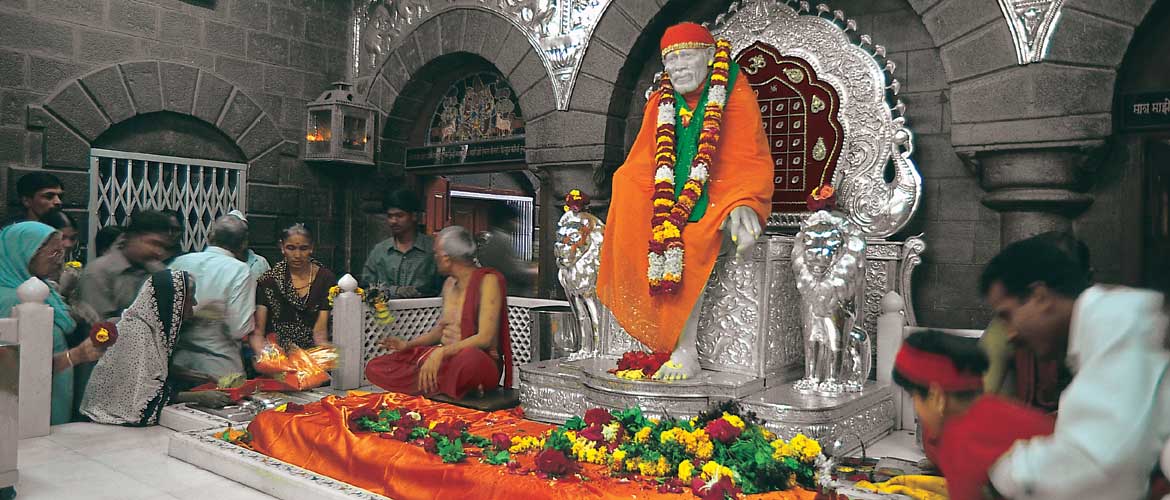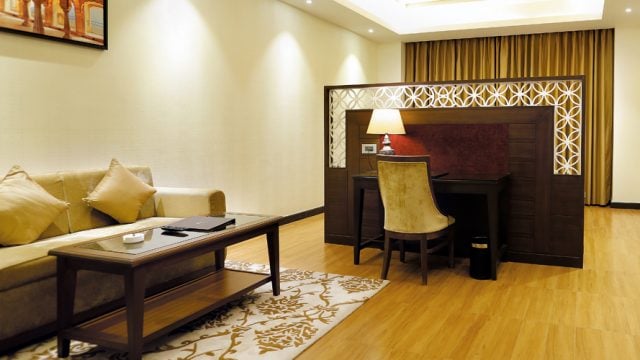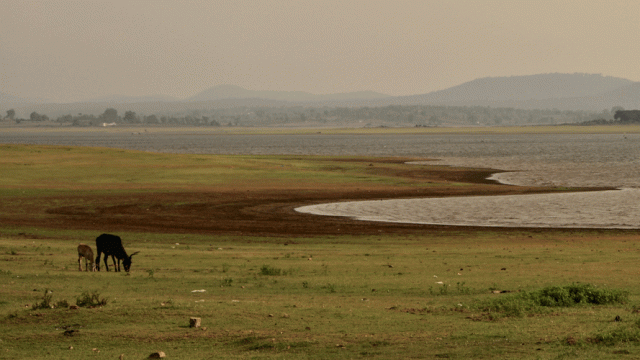The deep bass of drums, the higher octave of prayer bells and cymbals seeking divine
The morning puja is known as Kakad aarti, an elaborate procedure wherein the fakir saint is awakened – the mosquito nets placed over his statue at night are removed and the priests prepare to bathe him in milk and rose water.
On 15 October, 1918, Sai Baba attained samadhi (salvation, not death), but in Shirdi his presence is very real even today. Indeed, Shirdi is all about this wandering ascetic, for without him this would have been just another village in the heart of Maharashtra, with a population of a thousand odd citizens.
THINGS TO SEE AND DO
Distances seem exaggerated in Shirdi. What is referred to as the other end of the town is, in reality, a breezy 10-minute walk, through narrow lanes fringed by stalls selling flowers, sweets, trinkets and other items that devotees offer to Sai Baba. There are even Tibetans here selling woollies. Music blares from almost every stall; devotional and popular Bollywood songs mingle to create an eclectic medley as one walks down the streets.
TIP Leave your footwear with the stall owner from whom you buy your puja offerings; the service is free and saves you the jostling at the ‘shoe minding’ stall at the entrance to the temple complex
Samadhi Mandir of Sai Baba
The entire town seems to revolve around this shrine in which a life-sized Italian marble statue of the saint presides. The shrine is also known by the name of ‘Butty Wada’, after the man who built it – Gopalrao Butty of Nagpur. There is invariably a long line of devotees waiting for a darshan. Be prepared to wait for up to three or four hours on Thursdays, the special day of the saint, and on weekends, holidays and during festivals.
Devotees must note that all religious functions and pujas on the temple premises are to be arranged and performed through the office of the Sansthan. Payments for these are to be made at the office against a receipt. Boxes have been provided by the Sansthan in the temple itself to receive the devotees’ dakshina (offerings). Offerings in cash or kind to Shri Sai Baba should always be made at the office against a receipt.
Since the temple has a limited capacity, entrance is on a first-come basis. This means getting there early or obtaining a special VIP pass from the Sansthan office the previous day.
Timings 4.30am–10.00pm

Dwarkamai
This is the old village mosque where the 20-year-old Sai Baba took up residence in 1858 when he first arrived in Shirdi as part of a marriage procession, and where he lived for the remaining 60 years of his life. The two-level structure houses portraits and relics of Sai Baba and some items of everyday use that belonged to him.
Chavadi
To the east of Dwarkamai is the place where Sai Baba slept on alternate nights. It contains the wooden bed and white chair that were used by him.
Thursday Palki Procession
Every Thursday, the holy day of Sai Baba, a palkhi procession is taken through the streets of Shirdi. A framed photograph of the saint, along with the slippers he wore, the chillum (traditional pipe) that he smoked and the stick he carried, are taken out on a palanquin hoisted on the shoulders of priests. The procession starts at 9.00pm from Samadhi Mandir, proceeds to Dwarkamai, on to Chavadi and then back to the main temple.
TIP There is a lot of jostling during the procession, and special care should be taken if kids are brought along
Gurusthan
This is a shrine built around a neem tree under which Sai Baba sat when he first came to Shirdi. In front of the portrait of Sai Baba enshrined here is a shivalinga and a Nandi bull. Photos of the 12 jyotirlingas are also kept in the temple.
Lendi Baug
This is a small garden that was watered daily by Sai Baba who would drop by every morning and afternoon and rest under the neem tree. There’s also the samadhi of Shyamsunder, a horse that would bow whenever it passed Sai Baba.
Cottage of Abdul Baba
Located opposite Chavadi is the residence of Sai Baba’s friend Abdul Baba. His descendants dust the Holy Koran and the portraits of the two friends with peacock feathers and sprinkle holy dust over visitors.
House of Laxmibai Shinde
This is the place where Sai Baba received food and gave nine coins in exchange for it just before attaining samadhi. The coins, the last gift of the saint in his lifetime, are framed and enshrined in the humble hut.
WHERE TO STAY AND EAT
Shirdi is essentially a small overgrown village and all the hotels here are no more than a 10-minute walk away from the main temple complex.
Shri Sai Baba Sansthan offers a range of accommodation. Bookings can be done at W shrisaibabasansthan.org. Hotel Sun-n-Sand (Tel: 02423- 255728-30; Tariff: ₹5,000–22,000) comes with a multi-cuisine restaurant, swimming pool and more. It is offers a free shuttle service to the temple.
The Shraddha Sarovar Portico (Tel: 256630; Tariff: ₹4,500–11,000, with breakfast and dinner) has a pool, restaurants and a rest room for drivers. MTDC runs Pilgrim’s Inn (Tel: 255194-97; Tariff: ₹995–2,500), which has a restaurant.
Most hotels in Shirdi have attached restaurants. There are also a number of decent food and tea stalls all over the town that cater to tourists. The Sai Baba Sansthan serves food in the Prasadalay complex: breakfast (puri bhaji and sweets) from 7.00–11.00am and meals (at a nominal cost of ₹20– 50) from 10.00am–10.00pm.
AROUND
Shani Shingnapur (74 km)
Shani Shingnapur in the Ahmednagar District is named after the Hindu god Shani (planet Saturn). The village houses an open temple, at the centre of which is a five-and-a-half-feet tall black rock that is installed on an open-air pedestal, symbolising the god Shani, who is worshipped in order to chase away dangerous supernatural beings such as ghosts. The temple witnesses a high footfall every amavasya (new moon day), believed to be an auspicious day to appease Shani.
Despite such intrusions from pilgrims, houses in this village – home to around 4,000 people – have frames, at the entrance, but no doors. Same goes for the banks and ATMs here. Even the main temple has no doors, as the villagers believe that Shani is a perpetually ‘alive’ god. Barring a handful recent incidents, no cases of robbery or theft have been recorded here. The villagers believe that anyone who involves themselves in such activities will face bad luck.
Local taxis ply to Shani Shingnapur, from Shirdi. For more information, contact Maharashtra Tourism office (Tel: 0253-2570059) in Nashik.
|
FAST FACTS |
|
When to go All year round |
|
Information |
|
Executive Officer Shri Sai Baba Sansthan, Shirdi |
|
Tourist Office |
|
MTDC, Shirdi |
|
GETTING THERE |
|
Region Khandesh & Nashik Location At an elevation of 504 m in Ahmednagar District Distance 83 km E of Nashik Route from Nashik Take SH10 via Sinde, Sinnar, Pangri, Vavi and Zagade phata Air Nearest airport: Aurangabad (130 km/ 3 hrs). Taxi costs about ₹2,200 |
|
Rail Nearest railheads: Sainagar (2 km); Kopargaon (13 km/ 20 mins). Taxi ₹500. However, the most convenient connection is with Manmad (57 km/ 1.5 hrs). Taxi ₹1,200 |
|
Road From Nashik take SH10 via Sinde, Sinnar, Pangri, Vavi and Zagade phata. |
|
Bus Plenty of ST buses ply to Shirdi from all major cities in Maharashtra |
Maharashtra
Maharashtra Guide
OT Getaway Guides





